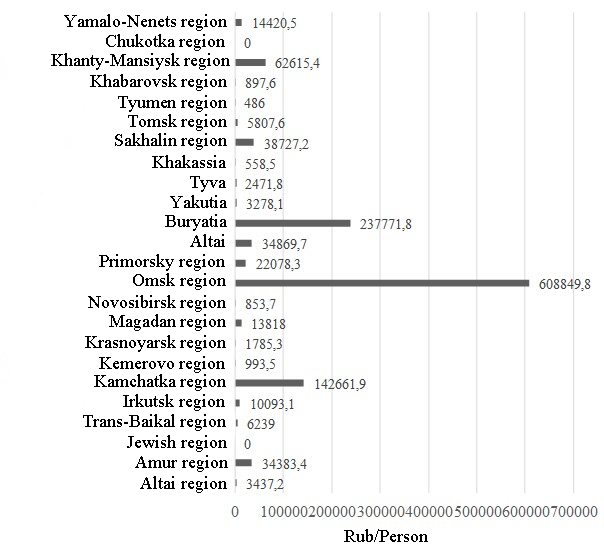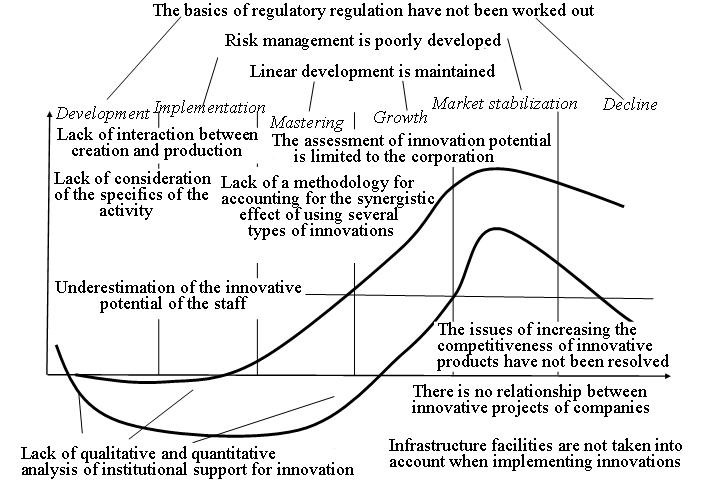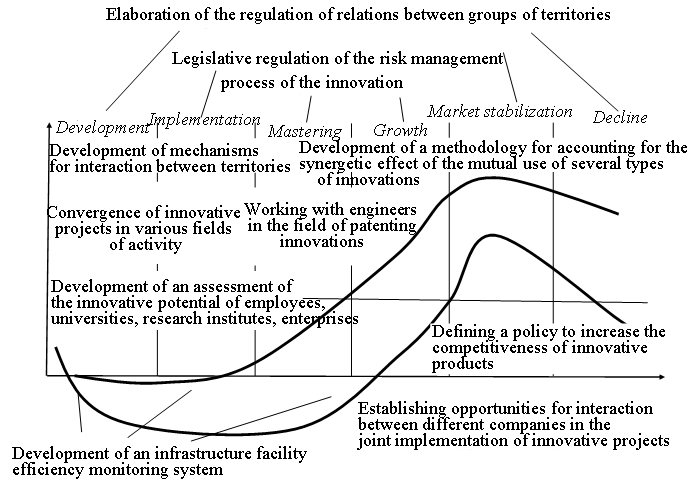|
MAIN PAGE
> Back to contents
Theoretical and Applied Economics
Reference:
Shirinkina E.V., Volkorez A.A.
Classification of risks in the risk management system of innovative development of Russian regions
// Theoretical and Applied Economics.
2023. № 4.
P. 59-72.
DOI: 10.25136/2409-8647.2023.4.68755 EDN: OHHPCJ URL: https://en.nbpublish.com/library_read_article.php?id=68755
Classification of risks in the risk management system of innovative development of Russian regions
Shirinkina Elena Viktorovna
PhD in Economics
Associate professor, Department of Management and Business, Surgut State University
628412, Russia, Tyumenskaya oblast', g. Surgut, ul. Lenina, 1, kab. 510

|
shirinkina86@yandex.ru
|
|
 |
Other publications by this author
|
|
|
Volkorez Aleksei Aleksandrovich
Postgraduate student, Department of Management and Business, Surgut State University
628412, Russia, Tyumen region, Surgut State University, Lenin str., 1

|
shirinkina86@yandex.ru
|
|
 |
|
DOI: 10.25136/2409-8647.2023.4.68755
EDN: OHHPCJ
Received:
19-10-2023
Published:
31-12-2023
Abstract:
The relevance of this study is due to the fact that risk management is a task assigned to each region of the Russian Federation, which is of particular importance in modern conditions. On the one hand, this is due to the requirements of the global market, where innovation is a recognized tool for improving competitiveness, solving socio-economic problems of society. On the other hand, this is necessary due to the increasing distortions of key indicators of regional innovative development of the country, which requires taking measures to preserve the sustainable development of highly innovative territories and the intensification of laggards, taking into account the sectoral and other specifics of their functioning. The subject of the study is the mechanism of risk management based on the identification and classification of risks and opportunities of the eastern regions of Russia in ensuring effective innovative development. The novelty of the research lies in the fact that the authors present the key directions for improving the risk management mechanism of the innovation space of the regions of Russia, taking into account the differentiation of the regional economic space in the direction of establishing a high-quality and sustainable system of interaction between objects and subjects of the innovation space based on the identified priorities. Due to the fact that risk management of innovative development has been the object of research in domestic dissertations for more than 25 years, the question arose: what risks were identified, and recommendations for their solution were offered by the authors during this period ? How much has the set of analyzed risks and challenges changed (and has it changed) ? How has the content of the approaches and methods of risk management proposed for the activation of innovative development changed ? To answer these questions, more than 60 doctoral dissertations, defended over the past 25 years, devoted to risk management of innovative processes in the regions, were analyzed.
Keywords:
risk, classification, risk management, innovation, development, regions, efficiency, methodology, Problems, challenges
This article is automatically translated.
You can find original text of the article here.
Introduction.
Ensuring effective innovative development is a task set for each region of the Russian Federation, which is of particular importance in modern conditions. On the one hand, this is due to the requirements of the global market, in which innovation is a recognized tool for improving competitiveness and solving socio-economic problems of society. On the other hand, this is necessary due to the increasing distortions of key indicators of the country's regional innovative development, which requires taking measures to preserve the sustainable development of highly innovative territories and intensify lagging ones, taking into account the sectoral and other specifics of their functioning. On the third hand, in conditions of high variability of conditions and factors of development of the state and regions, an increasing number of challenges and threats, each territory is forced to solve the task of innovative development in parallel with the resolution of current problems. The above has great depth and acuteness for the regions of Russia, which predetermined their choice as an object of research.
The subject of the study is the mechanism of risk management based on the identification and classification of risks and opportunities of the eastern regions of Russia in ensuring effective innovative development.
The novelty of the research lies in the fact that the authors present the key directions for improving the risk management mechanism of the innovation space of the regions of Russia, taking into account the differentiation of the regional economic space in the direction of establishing a high-quality and sustainable system of interaction between objects and subjects of the innovation space based on the identified priorities.
Problem statement.
Innovative activity, the effectiveness of which in the long term depends on the quality of R&D, is the object of research of a significant number of scientific papers. The number of doctors of sciences is often used to judge the level of innovative development of regions. Due to the fact that innovations have been the object of research in domestic dissertations for more than 25 years, the question arose: what problems were highlighted, and recommendations for their solution were offered by the authors during this period? How much has the set of analyzed problems changed (and has it changed)? How has the content of the approaches and methods proposed to enhance innovative development changed?
To answer these questions, more than 60 doctoral dissertations have been analyzed, defended over the past 25 years, on the management of innovation processes in the regions.
Determining the specifics of the problems identified in the works made it possible to identify those that, according to the researchers, are key (Table 1).
Table 1
The evolution of research in the field of highlighting key problems of innovative development
|
Author, year of publication of the work
|
Key issues
|
|
Bonyushko A.A.,
1998
|
the theoretical and methodological foundations of rational regulation and regulatory support of scientific and innovative activities of corporate and state integrators, interaction of elements of the mechanism of creation and production of innovations have not been sufficiently developed [1]
|
|
Bystrov V.V.,
2004
|
there is no mechanism for converting basic research into specific innovative projects [2]
|
|
Alekseyev A.A.,
2005
|
The synergistic result formed by the combination of all types of innovations is underestimated, the greatest emphasis is on modeling and predicting the behavior of a single product or organizational innovation. "The analysis of the integral totality of all innovations (at any point of monitoring) methodological does not allow predicting possible functional changes in the market position of the enterprise" [3]
|
|
Yerygin Yu.V.,
2005
|
the specifics of enterprises' activities, the management of their innovative development, the changed role and content of innovation activities at defense industry enterprises are underestimated, when innovations become a decisive factor in the development of the enterprise and, therefore, must reach the strategic level of corporate management [4]
|
|
Butch O.V.,
2006
|
there is no complete system picture of all groups of enterprise processes, including innovative processes [5]
|
|
Gilyazutdinova I.V.,
2006
|
there is no consensus on the content of innovations, the organization of innovative processes in different types of economic systems, the use of organizational and economic factors to enhance innovation, the formation of an innovative type of development of economic systems; many problems arise in the process of integrating innovative systems into functioning systems; little attention is paid to the interaction of organizational, economic and organizational-technological factors in innovative conditions, there are no methodological approaches to the formation of institutional structures of the innovative economy [6]
|
|
Gorshenin V.P.,
2006
|
there remains high uncertainty in the implementation of innovations associated with the need to identify methods and mechanisms of influencing the innovative activity of Russian corporations; research on innovation potential, as a rule, is limited to the level of the corporation, and the innovative potential of personnel is not considered as an independent element of intra-corporate institutions; there is no applied tools for assessing the innovative activity of corporations in relation to the innovative potential of personnel, insufficiently developed and the quantitative criteria and indicators of the innovative potential of the staff are justified [7]
|
|
Egorova M.V.,
2009
|
methodological issues in the field of the formation and development of regional innovation systems have not yet received sufficient attention, and at the moment there is no generally accepted understanding of the structure, functions and mechanisms of their formation and functioning [8]
|
|
Demkin I.V.,
2010
|
insufficient attention is paid to the issues of interdependence of innovative projects of the company, comparison of expected losses and return on investment, quantitative assessment of the level of innovation risk at the enterprise scale, organization and management of innovation risk, interconnection of innovation risk management with cash flow and the value of the portfolio of innovative projects of the enterprise. The need to manage innovation risk is only being comprehended at the enterprise [9]
|
|
Abramov V.I.,
2012
|
There are no significant revolutionary shifts in the national innovation system. There is no system for the effective use of national investment resources, and there are trends in their placement in projects with questionable, undefined innovative potential. There is a pronounced problem of quantifying the innovation potential in the examination of projects [10]
|
|
Queen E.V.,
2015
|
The issues of methodology and practice of forming a patent information support system in Russia based on the functioning and development of innovative network-type infrastructure entities in this area currently remain practically unexplored. The absence of a methodological and methodological basis for the implementation of the network principle in the organization and management of the process of patent and information support for innovation [11]
|
|
Governors A.M.,
2016
|
persons and bodies making managerial decisions do not always act rationally; issues related to the justification of criteria for the effectiveness of financial support for project-oriented management of innovative development of economic sectors have not received the necessary development; the problem of developing a comprehensive strategy for innovative development of economic sectors based on a systematic approach remains unresolved in general; the role and possibilities of the cluster initiative in the implementation of organizational, managerial and technological innovations at the level of individual sectors of the economy in conditions of a shortage of financial resources has not been sufficiently studied [12]
|
|
Kostygova L.A.,
2016
|
problems of sustainable cluster development, clarification and structuring of conditions and factors of sustainable development at a high level of innovative development based on territorial innovation clusters (TIC). The issues of the multilevel structure of industry and its impact on cluster policy and TIC organization have not been studied in depth [13]
|
|
Dedov S.V.,
2019
|
To date, the theoretical and methodological aspects of the problem of effective innovation management have not received an exhaustive scientific interpretation; the existing scientific discussion regarding resource provision and its role in ensuring the effectiveness of innovation management is characterized by narrow focus. At the same time, insufficient evidence is found for a number of conclusions of the presented works [14]
|
Methodology and conditions of the study.
Using the materials of state programs for the economic and innovative development of regions as an information base for the study, we will analyze the availability of resource opportunities for innovation activities.
The choice of these regions for research is due to the interest in identifying how their innovative activities are structured, since, on the one hand, in conditions of unfavorable natural and climatic conditions, distance from the highly developed center of the country, solving priority socio-economic problems is a priority, on the other, these regions are also forced to follow a common vector of innovative development Russia and implement relevant projects.
The study of the possibilities of the regions of the eastern part of Russia reveals a significant differentiation in all resource components (see Fig.1).

Fig. 1. The amount of financing of innovation activities per 1 person in 2022, RUB/person.
Thus, it should be said that there is a developed resource base for innovative activities in the regions of the eastern part of the country. However, in the context of regions, there is a sharp differentiation in the distribution of innovative resources, which requires appropriate adjustments to implement an effective innovation policy.
At the same time, each region highlights a fairly significant number of risks of implementing the state program of innovative development. However, it can be noted that, speaking of both external and internal risks, the first problem area is financing. In each region, there is a fear that due to certain circumstances, the impact of challenges and threats, funding may stop (or significantly decrease), which will affect the quality of the program implementation. Nevertheless, there are quite optimistic prospects for innovative development in each region.
To increase the connectivity of the innovation space of the Eastern macroregion, it is necessary to establish bilateral and multilateral partnerships between its subjects and facilities, conduct regular monitoring of the implementation of all agreements, and the effectiveness of inter-facility activities.
It requires the introduction of "flexible" management methods aimed at improving the efficiency of the current management system. In addition, it is necessary to continuously publish information about interterritorial cooperation in the media and hold various events.
Discussion of the results of the study.
Generalization of views on the existence of current and a set of future problems of innovative development of society, allows us to present their following graphical representation within the framework of the classical life cycle of innovation (Fig. 2).

Fig. 2. Key problems of innovation development in the framework of the life cycle.
It is undoubtedly possible to talk about the presence of some kind of evolutionary process in changing views on the problems of innovative development of the state, regions, and individual enterprises. So, if in the early 1990s, researchers tended to believe that not only a methodological, but also a theoretical description of effective innovative development, understanding the path of development of society according to an innovative scenario, is missing [15], today researchers tend to focus on in-depth study of individual elements of innovation, identification and prediction of the behavior of factors, risks and threats to the innovation environment.
It is important for modern authors to consider the need for comprehensive interaction between various participants in the innovation process, the search for an opportunity to interconnect innovative projects of various companies.
Among the problems causing the low innovative activity of the Russian economy, the following are highlighted: the presence of a small number of business entities engaged in fully innovative entrepreneurial activity, the incompatibility of the previous system of organizing innovative activities with the new business conditions after the 90s; the subjective disregard for the operation of economic laws that has developed over the years of totalitarian development; the monopoly position of the majority of commodity producers and lack of competition.
The innovation process, being both a product and a driving force of economic development, from the point of view of N.L. Frolova has opportunities and limitations determined by market failures and government intervention in the regulation of the innovation sphere.
The greatest attention of researchers is focused on system-wide problems and issues of the first stages of the innovation life cycle. Many point to the lack of methodology for the formation and development of regional innovation systems as a whole, their point-based, local formation, and the complexity of integrating innovation systems into existing economic systems. As for the beginning of the life of innovation, here researchers agree in the presence of a large complex of problems of resource provision of innovation and the effectiveness of its management, underestimation of the innovative potential of a new project, which often affects investment in a dubious undertaking.
What is proposed by leading researchers in the field of innovative development of economic systems at various levels? The significant variability of the proposals affects:
1) the mechanism of regulation of innovation activity in the region;
2) the methodology of the criterion assessment of the effectiveness of innovation activities in the region and at the level of an individual enterprise;
3) the organizational and economic structure of an innovative enterprise;
4) directions for increasing the innovative potential of territories, enterprises, and personnel.
The analysis made it possible to identify the following proposals for the development of structural components, which seem to be the most relevant at the present time, taking into account the identified problems of innovative development:
1) at the national level:
– the concept of a collaborative technological circuit, which is part of a regional innovation system, within which a collaborative environment is being formed that promotes the integration interaction of its actors.
2) at the regional level:
– a methodological approach to managing transitions between the stages of the innovation process, ensuring the continuity of their flow; a mechanism for integrating business and higher education.
3) at the level of industries (enterprises):
– a new procedure for organizing infrastructure to ensure the innovation activity of the industrial sector based on network interaction; methodology for assessing the innovative potential of infrastructure to ensure the innovation activity of industrial enterprises based on the potential of territorial systems and innovative enterprises; architecture for building an efficiency management system for the development of innovative infrastructure;
– a methodological approach to monitoring the implementation of innovative housing and communal services development projects;
– methodology for building a map of strategic targets for the development of industrial enterprises; the process of identifying managerial and financial and investment risks.
Taking into account the impressive set of problems that persist to this day, the pool of recommendations for the development and improvement of the effectiveness of certain aspects of innovation activity in a small part is focused on strengthening the joint activities of participants in innovation activities. Thus, in order to overcome this negative situation, it is proposed to focus on the following structural components of increasing the innovation activity of the region (Fig. 3).

Fig. 3. Proposals for the development of structural components to enhance the management of the innovation space of the region.
The leading mechanisms of risk management of the innovation space should be: mesoeconomical cooperation, implementation of project management, activation of public-private partnership:
– development of a mechanism for the implementation of a full innovation cycle in universities in the territories of the macroregion, the development of interuniversity innovation collaborations;
– activation of innovative entrepreneurship;
– spatial development of innovative business as a basis for involving the entire population in innovative development;
– creation of cooperative ties between universities with science and production, involvement of universities in territorial production clusters;
– intensification of technology transfer by integrating creative sectors of the economy into value chains;
– implementation of a risk management system.
Conclusions and further directions of research.
The presence of a large number of problems that persist in the regions in the field of innovative development suggests that there are no fewer risks associated with the implementation of relevant government programs. The risk analysis by region made it possible to identify the following key:
- deterioration of the economic situation in the country and the world;
- low interest of participants in the innovation process, inconsistency of their actions;
- insufficient funding;
- changes in legislation in the field of innovation (investment activity.
Thus, each region allocates a fairly significant number of risks to the implementation of the state program of innovative development. However, it can be noted that, speaking of both external and internal risks, the first problem area is financing.
In each region, there is a fear that due to certain circumstances, the impact of challenges and threats, funding may stop (or significantly decrease), which will affect the quality of the program implementation. Nevertheless, there are quite optimistic prospects for innovative development in each region.
Thus, we should talk about the need to improve the risk management mechanism of the innovation space along a single line of building the competencies of a wide part of the population in terms of changing mentality, innovators - in implementing all stages of the innovation life cycle, management bodies – in adapting them to the changing requirements of the innovative economy.
References
1. Bonyushko, A. A. (1998). Regulatory support and regulation of innovative activities of state research centers. Dissertation...Dr.Econ. Sciences: 08.00.05 St. Petersburg.
2. Bystrov, V.V. (2004). Methodological foundations for the formation of an organizational and economic mechanism for managing innovation at enterprises being converted (using the example of enterprises of the military-industrial complex): abstract of thesis. dis. dr. econ. Sciences: 08.00.05. – Vladivostok.
3. Alekseev, A.A. (2005). Theory and methodology of managing the system of innovative development: dis. dr. econ. Sciences: 08.00.05. Moscow.
4. Erygin, Yu.V. (2007). Methodology and tools for planning sustainable innovative development of defense industry enterprises: abstract. dis. dr. econ. Sciences: 08.00.05. Krasnoyarsk.
5. Buch, O.V. (2006). Process approach to managing the system of innovative activity of an industrial enterprise: abstract. dis. dr. econ. Sciences: 08.00.05. Kaliningrad.
6. Gilyazutdinova, I.V. (2009). Methodology of organizational and economic development of innovative economic systems: dis. dr. econ. Sciences: 08.00.05. Kazan.
7. Gorshenin, V.P. (2006). Managing the innovative potential of corporation personnel: abstract. dis. dr. econ. Sciences: 08.00.05. Chelyabinsk.
8. Egorova, M.V. (2009). Mechanisms of formation and functioning of the regional innovation system: dis. dr. econ. Sciences: 08.00.05. Kazan.
9. Demkin, I.V. (2010). Managing innovation risk in industry: methodology, organization, models: abstract of thesis. dis. dr. econ. Sciences: 08.00.05. Moscow.
10. Abramov, V.I. (2012). Methodology for assessing innovation potential: dis. dr. econ. Sciences: 08.00.05. Samara.
11. Queen, E.V.(2015). Formation and development of patent and information support for innovation: dis. dr. econ. Sciences: 08.00.05. St. Petersburg.
12. Governors, A.M. (2016). Methodology and organization of management of innovative development of the industry: abstract. dis. dr. econ. Sciences: 08.00.05. Moscow.
13. Kostygova, L.A. (2016). Formation of a mechanism for sustainable development of Russian industry based on territorial innovation clusters: dis. dr. econ. Sciences: 08.00.05. Moscow.
14. Dedov, S.V. (2014). Resource support for effective management of innovation activities: theory, methodology, strategy: dis. dr. econ. Sciences: 08.00.05. Kursk.
15. Shelegeda, B.G., Sharnopolskaya, O.N., & Vasylishina, L.N. (2013). Innovacionnye resursy sovershenstvovaniya professional'noj podgotovki menedzherov vysshej kvalifikacii [Innovative resources for improving the professional training of highly qualified managers]. Scientific works of the Donetsk National Technical University. Series: economic, 4(46), 40-51.
First Peer Review
Peer reviewers' evaluations remain confidential and are not disclosed to the public. Only external reviews, authorized for publication by the article's author(s), are made public. Typically, these final reviews are conducted after the manuscript's revision. Adhering to our double-blind review policy, the reviewer's identity is kept confidential.
The list of publisher reviewers can be found here.
The subject of the study. Based on the title, it seems possible to conclude that the article should be devoted to the development of risk classification in the risk management system of innovative development of Russian regions. The content of the article partially corresponds to the stated topic, but in fact does not contain an author's block, but is based solely on the systematization and generalization of research results conducted by other authors. The research methodology is based on the presentation of well-known facts and judgments. On the one hand, the positive perception of familiarization with the article is formed due to the presence of graphic objects in it (table and figure). Unfortunately, no general scientific or special methodological apparatus is used in terms of data analysis. When finalizing the article, it would also be worth paying attention to the construction of graphic objects containing the results of studying the state of the research subject in structure/dynamics, etc. The relevance of the study of issues related to risk management of innovative development of Russian regions is beyond doubt, since this fully meets the national interests of the development of the Russian Federation, as well as ensuring technological sovereignty our state. These tasks were set by the President of Russia in 2018,2020,2022. Accordingly, the demand for high-quality scientific research on the stated topic is beyond doubt. Potential readership is interested in well-founded problems and reasoned ways to solve them. Issues related to the implementation of risk management and identification of possible risks are of particular interest, since this will allow for high-quality socio-economic, innovative and budgetary forecasting, which is extremely necessary to achieve the stated goals and objectives. There is no scientific novelty in the materials submitted for review. Style, structure, content. The style of presentation can be considered scientific only from the point of view of the absence of colloquial statements and expressions. At the same time, due to the lack of used scientific methodology, the material submitted for review is an abstract, not a scientific article. The structure of the article has not been built by the author. When finalizing the article, it is recommended to highlight the blocks "Introduction", "Problem statement", "Methodology and research conditions", "Research results", "Discussion of research results", "Conclusions and further research directions". In terms of content, the article should be filled with reasonable identified problems and reasonable ways to solve them. It is also necessary to build a declared risk management system for the innovative development of regions and show what risks exist? What is the essence of the author's classification? What is its practical significance? How does it differ from those that are already contained in the scientific literature? Bibliography. Familiarization with the bibliographic list allows us to conclude that it is scarce, as well as the lack of knowledge of scientific publications published after 2016. At the same time, in the last 7 years, a fairly large number of studies have been conducted on the stated topic, both in Russia and abroad. Also, when filling the article with the results of processing numerical data, it is necessary to cite the sources from which they will be borrowed. Appeal to opponents. When filling the article with meaningful components in terms of the author's approach to risk classification in the risk management system of innovative development of Russian regions, it is also necessary to discuss the results obtained with the results contained in the scientific works of domestic and foreign authors. This will make it possible to have a positive impact on the formation of scientific novelty that is missing in the current edition. Conclusions, the interest of the readership. Taking into account all the above, we conclude that the article as presented does not represent any scientific or practical value. Accordingly, it will not be in demand from a potential readership. At the same time, the revision carried out taking into account the comments indicated in the text of the review will eliminate this problem. In this regard, the article should not be rejected, but sent for revision.
Second Peer Review
Peer reviewers' evaluations remain confidential and are not disclosed to the public. Only external reviews, authorized for publication by the article's author(s), are made public. Typically, these final reviews are conducted after the manuscript's revision. Adhering to our double-blind review policy, the reviewer's identity is kept confidential.
The list of publisher reviewers can be found here.
The subject of the research in the reviewed article is the mechanism of risk management based on the identification and classification of risks and opportunities of the eastern regions of Russia in ensuring effective innovative development. The research methodology is based on the use of materials from state programs for the economic and innovative development of regions as an information base, the use of general scientific research methods, visualization of the results of information processing. The authors attribute the relevance of the work to the fact that ensuring effective innovative development is an important task for each region of Russia. The scientific novelty of the work consists in the fact that the authors present the key directions for improving the risk management mechanism of the innovation space of the regions of Russia, taking into account the differentiation of the regional economic space in the direction of establishing a high-quality and sustainable system of interaction between objects and subjects of the innovation space based on the identified priorities. Structurally, the following sections are highlighted in the article: Introduction, Problem statement, Methodology and research conditions, Discussion of research results, Conclusions and further research directions, Bibliography. The article examines doctoral dissertations defended in various regions of the country over the past 25 years on the management of innovation processes in the regions, traces the evolution of research in the field of highlighting key problems of innovative development. Data on the volume of financing of innovation activities per 1 person in 2022 in the context of the regions of the eastern part of Russia are presented, significant differentiation in all resource components is revealed. The paper shows the key problems of innovation development within the framework of the life cycle in the form of schematic drawings, as well as proposals for the development of structural components that make it possible to activate the management of the innovation space of the region. The most relevant proposals for the development of structural components of the risk management mechanism are formulated separately for the national, regional levels, as well as for the level of industries and enterprises. The authors consider mesoeconomical cooperation, the implementation of project management, and the activation of public-private partnerships to be the leading mechanisms of risk management. The bibliographic list includes 15 sources – dissertations for the degree of Doctor of Economics, as well as scientific publications on the topic in Russian. For each literary source in the text there is an address reference confirming the existence of an appeal to opponents. The reserves for improving the publication include the concretization of the approaches proposed by the authors to managing the risks of innovative development of regions in relation to any particular subject of the Russian Federation or industry. The topic of the article is relevant, the material reflects the results of the research conducted by the authors, contains elements of increment of scientific knowledge, corresponds to the topic of the journal "Theoretical and Applied Economics", may arouse interest among readers, and is recommended for publication.
Link to this article
You can simply select and copy link from below text field.
|
|





